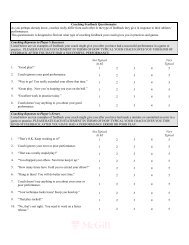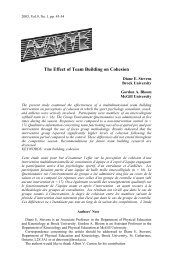International Journal of Sport Psychology
International Journal of Sport Psychology
International Journal of Sport Psychology
Create successful ePaper yourself
Turn your PDF publications into a flip-book with our unique Google optimized e-Paper software.
experience and specific expertise. Thus, there was a difference in saccade<br />
rate between goalkeepers and field players during drag flicks, but not during<br />
the push or slap actions. Rendell and Morgan (2005) interpreted this finding<br />
as further evidence for the suggestion that the development <strong>of</strong> expertise is<br />
rather task-specific.<br />
Williams, Ward and Chapman (2002) examined the influence <strong>of</strong> a videobased<br />
perceptual training program in 24 female hockey players using a<br />
typical pre-post-test design. The experimental group trained with video<br />
sequences <strong>of</strong> penalty flicks while neither the control nor the placebo group<br />
received this special training. Results revealed that the goalkeepers who<br />
underwent the perceptual training reduced their response times significantly,<br />
while maintaining the same accuracy level as in the pre-test. Furthermore,<br />
Williams and colleagues included a transfer test from the laboratory to the<br />
field. Results showed that the perceptual training group also reduced their<br />
response time in the field setting. Thus, Williams et al. (2002) provided<br />
evidence that perceptual skills trained with a video-based perceptual training<br />
program transfer to the field setting.<br />
Panchuk and Vickers (2006) examined gaze and motor behaviour <strong>of</strong><br />
expert goalkeepers when asked to react to wrist shots taken from 5 m and 10<br />
m on ice. They showed that the ability to save the puck depended on the<br />
location, onset and duration <strong>of</strong> the final fixation prior to the saving action,<br />
referred to as the quiet eye period. Best performances where achieved when<br />
the quiet eye was directed to the puck and stick area or to the ice in front <strong>of</strong><br />
the puck. Yet, the body <strong>of</strong> the shooter was rarely focussed during the quiet<br />
eye period.<br />
To the best <strong>of</strong> our knowledge, and despite its importance, no researchers<br />
have looked into penalty corners in field-hockey. Additionally, in most research<br />
on penalty situations in other sports, investigators have tended to compare<br />
skilled with less skilled goalkeepers. However, even at high levels <strong>of</strong> performance<br />
some goalkeepers perform significantly better than others in penalty situations<br />
(e.g., Savelsbergh et al., 2005; Van der Kamp, 2001). Do these performance<br />
differences relate to different visual information pick-up strategies?<br />
In order to pick up the most useful information and to stop a penalty<br />
corner, goalkeepers may use two different strategies. One strategy could be<br />
to first focus on the pusher and then follow the ball to the centre <strong>of</strong> the circle<br />
where the stopper and drag flicker prepare to shoot the ball at the goal. This<br />
is referred to as the ‘keep the eye on the ball’ strategy (Cr<strong>of</strong>t, Button, &<br />
Dicks, 2009; Savelsbergh & Davids, 2002; Whiting, 1969). Alternatively,<br />
goalkeepers may directly focus on the centre <strong>of</strong> the circle to monitor the<br />
behaviours <strong>of</strong> the stopper and the drag flicker. Following the ‘keep the eye on<br />
330




